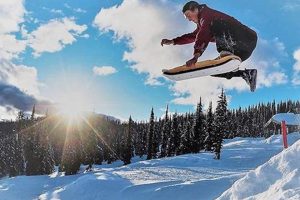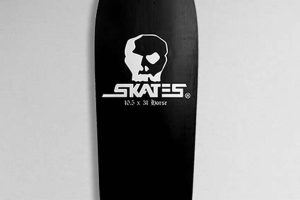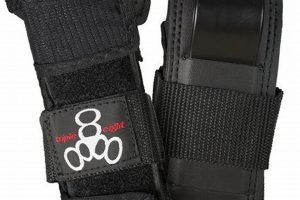Specialized roller skates engineered for artistic expression and footwork are known for a low-cut boot allowing maximum ankle mobility. These skates facilitate intricate dance moves and spins performed on roller rinks or smooth surfaces. For example, performers utilize this equipment to execute complex routines, showcasing agility and rhythm.
This type of skating equipment fosters creativity and physical fitness. Historically, it evolved from traditional roller skates, catering to a niche within the skating community focused on performance rather than speed or distance. The development allowed practitioners to push the boundaries of movement and artistry on wheels, contributing significantly to roller skating culture.
The subsequent sections will delve into the specific components, variations, maintenance, and selection criteria associated with choosing this type of equipment. Further discussion will also cover notable practitioners and influential innovations within the field.
Guidance for Optimal Performance
The following recommendations aim to enhance skill and longevity of skating equipment. Adhering to these suggestions contributes to a safer and more rewarding skating experience.
Tip 1: Boot Selection. Prioritize a snug yet comfortable fit. The boot should provide ample ankle support without restricting movement. Consider materials like leather or reinforced synthetics for durability and responsiveness.
Tip 2: Plate Mounting. Ensure precise plate mounting. Proper alignment affects stability and maneuverability. Seek professional assistance for optimal plate positioning to avoid discomfort or impaired performance.
Tip 3: Wheel Hardness. Choose appropriate wheel durometer based on skating surface. Harder wheels offer greater speed and slide on smooth surfaces, while softer wheels provide better grip on less refined surfaces. Experiment to find the ideal balance for a given environment.
Tip 4: Bearing Maintenance. Regularly clean and lubricate bearings. Clean bearings reduce friction and extend lifespan. Use a solvent to remove debris and apply a specialized lubricant to ensure smooth rotation.
Tip 5: Toe Plug Installation. Employ durable toe plugs for enhanced control. Well-installed toe plugs facilitate stops and footwork techniques. Select plugs made from resilient materials that withstand repeated impact.
Tip 6: Routine Inspection. Conduct regular inspections of all components. Check for wear and tear on boots, plates, wheels, and bearings. Address any issues promptly to prevent further damage and maintain safety.
These guidelines emphasize the importance of selecting the right equipment, proper maintenance, and a commitment to safety. Implementing these suggestions maximizes performance and extends equipment lifespan.
The subsequent section will summarize essential aspects related to equipment storage and transportation, ensuring prolonged usability.
1. Boot Flexibility
Boot flexibility in skating equipment is a critical determinant of maneuverability and performance. Its influence is particularly pronounced in specialized forms demanding a high degree of articulation and responsiveness.
- Range of Motion
Boot flexibility directly dictates the available range of ankle motion. A more flexible boot allows for deeper leans, sharper turns, and greater extension during intricate footwork. Limited flexibility restricts movement, potentially hindering execution of advanced maneuvers and increasing the risk of injury from overextension.
- Responsiveness and Control
The degree of boot flexibility affects the skate’s responsiveness to subtle shifts in weight and pressure. A highly flexible boot enables quicker reactions to changes in direction, affording enhanced control and precision. Conversely, a stiffer boot offers more stability but may sacrifice the ability to execute rapid, nuanced movements. This responsiveness is vital for precision.
- Energy Transfer
Flexibility influences the efficiency of energy transfer from the skater’s body to the skate. A properly flexible boot allows for a more natural and fluid transfer of power, minimizing energy loss and maximizing agility. A boot that is too stiff may absorb energy, reducing overall performance and increasing fatigue. Proper energy transfer can maximize agility on rink.
- Comfort and Adaptability
Boot flexibility contributes to overall comfort and the skate’s ability to adapt to individual foot anatomy. A more flexible boot can mold to the skater’s foot over time, providing a customized fit and reducing pressure points. Excessive stiffness can lead to discomfort and a less secure feel, hindering performance and increasing the likelihood of blisters or other foot-related issues.
These facets highlight the interconnectedness of boot flexibility with overall skating proficiency. The selection of an appropriate boot involves a careful balancing act, considering both the skater’s skill level and the specific demands of the activity. Balancing both comfort and control is the most important factor.
2. Plate Mounting
Plate mounting directly impacts the performance characteristics of equipment designed for specialized roller skating. The plate, the chassis connecting the boot to the wheels, dictates the skater’s ability to translate body movements into controlled action. Improper mounting introduces instability, reduces maneuverability, and potentially leads to equipment failure or injury. Precise alignment and secure attachment are therefore paramount. For instance, if the plate is mounted too far forward, the skater experiences difficulty maintaining balance during backward skating. Conversely, a plate mounted too far back can hinder forward acceleration and control during spins.
The choice of plate material and design also influences responsiveness. Lighter plates, often constructed from aluminum alloys, enhance agility and reduce fatigue. Conversely, heavier steel plates offer increased durability, suitable for high-impact maneuvers. The angle of the kingpins, which determine turning responsiveness, requires careful adjustment based on the skater’s skill level and skating style. A steeper kingpin angle results in quicker, more agile turns, while a shallower angle provides greater stability at higher speeds. Professionals commonly invest in customized plate mounting to achieve the desired blend of responsiveness and stability, carefully tailoring the setup to match their personal preferences and the specific demands of their routines.
In conclusion, plate mounting is a foundational element impacting the efficacy and safety of specialized skating equipment. The consequences of improper mounting range from diminished performance to elevated risk of injury. Understanding the interplay between plate positioning, material selection, and kingpin angle is essential for achieving optimal performance and unlocking the full potential of this equipment.
3. Wheel Hardness and Jam Skates
Wheel hardness, measured using the durometer scale, is a critical factor affecting the performance of skates designed for artistic roller skating. The selection of wheel hardness directly influences grip, slide, and overall maneuverability. Harder wheels, typically rated above 95A, offer minimal grip and increased slide, facilitating spins and controlled drifts. Softer wheels, generally below 90A, provide enhanced grip, enabling quick stops and precise footwork. The specific hardness chosen is often dictated by the skating surface, with smoother surfaces favoring harder wheels for speed and slickness, and rougher surfaces benefiting from softer wheels for improved traction. For example, a skater performing on a polished wooden rink might opt for 97A wheels, while a skater on a concrete surface might select 88A wheels.
The interplay between wheel hardness and skating surface dictates the responsiveness of equipment to the skater’s movements. Insufficient grip compromises the ability to execute controlled turns and maintain balance during complex routines. Conversely, excessive grip inhibits sliding maneuvers and impedes speed. The optimal wheel hardness, therefore, represents a balance between these two factors, tailored to the skater’s individual style and the specific demands of their performance. As a demonstration, a skater focused on spins and slides would intentionally select harder wheels to minimize friction and allow for easier execution of these maneuvers. Conversely, a skater prioritizing intricate footwork and quick stops would opt for softer wheels, maximizing grip and control.
In conclusion, the selection of appropriate wheel hardness is a foundational element in optimizing performance in artistic roller skating. Understanding the relationship between wheel hardness, skating surface, and desired skating style is essential for achieving optimal results. Selection affects the execution and quality of complex maneuvers. Furthermore, selecting inappropriate wheel hardness carries risk of compromised performance and heightened risk of injury.
4. Bearing Precision and Jam Skates
Bearing precision significantly influences the performance characteristics of artistic skating equipment, impacting speed, smoothness, and overall efficiency. High-precision bearings minimize friction, enabling greater velocity and fluidity during intricate maneuvers. The quality of these components is paramount for achieving peak performance.
- ABEC Rating and Performance
The Annular Bearing Engineers’ Committee (ABEC) rating system classifies bearing precision on a scale, with higher numbers indicating tighter tolerances and reduced friction. ABEC-7 or ABEC-9 bearings are frequently employed in skating equipment to maximize speed and minimize energy loss. For instance, a skater utilizing ABEC-9 bearings might experience a noticeable improvement in glide distance compared to using ABEC-3 bearings. Low friction improves skating speed.
- Material Composition and Durability
The materials used in bearing construction impact both performance and longevity. Chromium steel bearings offer a balance of hardness and corrosion resistance, while ceramic bearings provide superior speed and reduced friction due to their smoother surface and lower density. Ceramic bearings exhibit less heat buildup, maintaining performance during extended use. The choice of materials balances speed and durability.
- Lubrication and Maintenance
Proper lubrication minimizes friction and protects against wear and corrosion. Specialized lubricants designed for skating bearings reduce friction and extend lifespan. Regular cleaning and re-lubrication are essential for maintaining optimal performance. Neglecting maintenance can result in increased friction, reduced speed, and eventual bearing failure. Frequent maintenance ensures optimal performance.
- Impact on Maneuverability and Control
High-precision bearings contribute to enhanced maneuverability and control. Reduced friction allows for smoother transitions between movements and greater responsiveness to subtle shifts in weight. This heightened responsiveness enables skaters to execute complex routines with greater precision and fluidity. Precise bearings amplify control.
The selection of appropriate bearings, coupled with diligent maintenance, is critical for maximizing the performance and lifespan of skating equipment. Superior bearing precision translates directly into enhanced speed, fluidity, and control, empowering skaters to execute intricate maneuvers with greater confidence and finesse. In the long term, proper bearing maintenance saves money, and enhances performance.
5. Toe Plug Design and Jam Skates
The toe plug constitutes a critical interface for skaters executing intricate footwork, stops, and pivots. This component, typically constructed from durable materials such as reinforced rubber or composite polymers, serves as a primary point of contact with the skating surface, enabling controlled deceleration and stability. The design parameters of toe plugs directly influence the skater’s ability to perform advanced maneuvers; a poorly designed plug may compromise control, leading to instability or even injury. For example, a plug with inadequate surface area provides insufficient friction for abrupt stops, whereas an excessively large plug may hinder agility and increase the risk of tripping.
Variations in toe plug design cater to diverse skating styles and skill levels. Shorter, rounded plugs facilitate smoother transitions and enhanced maneuverability for skaters focused on dance-oriented routines. Conversely, longer, flatter plugs offer greater stability and control for skaters emphasizing powerful stops and aggressive footwork. Furthermore, adjustable toe plugs allow skaters to fine-tune the height and angle, optimizing the fit and feel to personal preferences and skating conditions. Skaters often replace factory-installed plugs with aftermarket options engineered for specific performance characteristics. Skaters focused on spin moves prefer shorter plugs for tighter turn radius.
In summary, the toe plug design significantly impacts the performance capabilities and safety. It is a critical component of a functional skate, serving as an essential link between the skater and the rink. Selecting and maintaining appropriate plugs ensures responsiveness and safe mobility. Understanding the nuances of plug geometry, material composition, and adjustability is crucial for skaters seeking to maximize their performance potential and minimize the risk of injury.
6. Truck Adjustability and Jam Skates
Truck adjustability, concerning the tightness or looseness of the skate trucks, directly influences the maneuverability and responsiveness of skating equipment. For artistic roller skating, this adjustment is crucial for adapting the skate’s turning radius to individual skating style and rink conditions. Tighter trucks offer increased stability, while looser trucks allow for quicker, more agile turns. The precise adjustment is a critical factor in executing complex maneuvers, influencing the skaters ability to maintain balance and control. For example, a skater performing intricate footwork may prefer looser trucks to facilitate rapid changes in direction. Conversely, a skater focusing on spins and jumps might opt for tighter trucks to enhance stability during landings.
The practical significance of understanding truck adjustability lies in the ability to fine-tune the skates for optimal performance. Improper adjustment can impede progress and increase the risk of falls. Experienced skaters often experiment with varying degrees of truck tightness to identify the settings that best complement their skating style and the characteristics of the skating surface. This iterative process involves incremental adjustments and careful assessment of the skates responsiveness. Adjusting the trucks is a balance between responsiveness and control. Furthermore, adjustability helps to maximize speed.
In summary, truck adjustability is a critical parameter in the configuration of equipment designed for artistic roller skating. It offers a means of tailoring the skate’s responsiveness to individual preferences and skating conditions. Mastering truck adjustment is essential for optimizing performance, enhancing control, and minimizing the risk of injury, contributing significantly to the overall skating experience.
7. Maintenance Schedule and Jam Skates
A proactive maintenance schedule directly impacts the performance and longevity of artistic roller skating equipment. Regular inspection and upkeep mitigate wear, prevent component failure, and preserve optimal functionality. Neglecting a consistent maintenance routine compromises control, reduces speed, and increases the risk of injury. For example, deteriorated wheel bearings, left unaddressed, impede smooth rotation, affecting execution of spins and jumps. Similarly, loose plate mounting screws compromise stability, diminishing a skater’s ability to perform intricate footwork. The interdependence between systematic maintenance and peak performance underscores its importance.
Specific maintenance tasks, performed at regular intervals, include bearing cleaning and lubrication, wheel rotation and replacement, boot and plate inspection, and hardware tightening. Bearing cleaning removes accumulated debris and grit, restoring rotational efficiency. Wheel rotation ensures even wear, maximizing wheel lifespan. Routine inspection of the boot and plate identifies potential structural issues, preventing catastrophic failure. Tightening loose hardware maintains structural integrity, preserving stability and control. The frequency of each task depends on skating intensity and environmental conditions, with more frequent maintenance required for skaters performing complex maneuvers in demanding environments. As an example, a professional skater practicing daily on a rough surface should implement a more rigorous maintenance schedule than a recreational skater using the equipment once a week.
In summary, a structured maintenance schedule is an indispensable element in sustaining the operational integrity and extending the usable life of artistic roller skating equipment. The proactive measures outlined above mitigate the adverse effects of wear and tear, preserving performance characteristics and enhancing safety. Consistent adherence to a maintenance regimen optimizes equipment value, minimizes repair expenses, and ensures continued proficiency for skaters of all skill levels. Prioritizing upkeep safeguards the equipment, preventing costly damage and enabling continued peak performance.
Frequently Asked Questions About Jam Skates
This section addresses prevalent inquiries regarding the usage, selection, and maintenance of specialized artistic roller skating equipment. Clarification of these points ensures a deeper understanding of optimal practices.
Question 1: What distinguishes jam skates from traditional roller skates?
This specialized equipment typically features a low-cut boot, facilitating enhanced ankle mobility essential for intricate footwork. Traditional roller skates often incorporate higher boots, providing greater ankle support but limiting flexibility.
Question 2: What wheel durometer is most suitable for jam skating?
The optimal wheel durometer depends on the skating surface. Smoother surfaces generally necessitate harder wheels (95A and above) for increased slide, while rougher surfaces benefit from softer wheels (90A and below) for enhanced grip.
Question 3: How frequently should bearings be cleaned and lubricated?
Bearing maintenance frequency is contingent on skating intensity and environmental conditions. Routine cleaning and lubrication every 10-20 hours of skating are advisable to maintain optimal performance and prolong bearing lifespan.
Question 4: How does truck adjustability affect skating performance?
Truck adjustability alters the turning radius of the skates. Tighter trucks enhance stability, while looser trucks increase agility. Proper adjustment optimizes maneuverability and control, catering to individual skating style.
Question 5: Why is proper plate mounting crucial?
Accurate plate mounting ensures balanced weight distribution and optimal responsiveness. Misaligned plates compromise stability, hinder maneuverability, and potentially lead to equipment failure or injury.
Question 6: What role do toe plugs play in jam skating?
Toe plugs facilitate controlled stops, pivots, and footwork techniques. Their design influences grip and maneuverability, impacting a skater’s ability to execute complex routines with precision and stability.
These FAQs provide foundational insights into key aspects of specialized skating equipment, guiding users toward informed decisions and best practices.
The subsequent section will delve into various styles and techniques employed within this specialized skating discipline.
Conclusion
This exposition has detailed the multifaceted aspects of specialized artistic roller skating equipment. From the importance of boot flexibility and plate mounting to the influence of wheel hardness, bearing precision, toe plug design, truck adjustability, and a consistent maintenance schedule, each element contributes significantly to the overall performance and longevity of this equipment. The technical nuances of these factors, coupled with informed decision-making, ensure a safe and rewarding skating experience.
Given the dynamic evolution of skating techniques and equipment innovations, continued research and meticulous attention to detail remain imperative. Further investigation into advanced materials and engineering principles will likely lead to enhanced performance and increased safety within this demanding discipline. The continued development and refinement of skating equipment will undoubtedly unlock new levels of artistic expression and athletic achievement.







